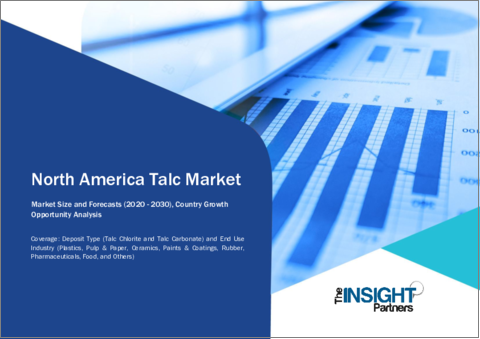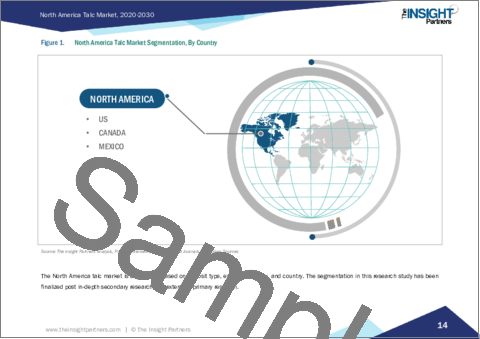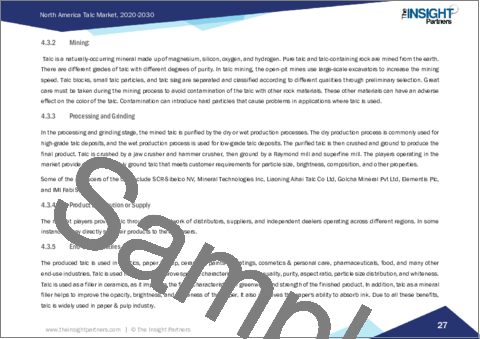|
|
市場調査レポート
商品コード
1389676
タルクの北米市場規模・予測、地域別シェア、動向、成長機会分析レポート収録範囲:デポジットタイプ別、用途別North America Talc Market Size and Forecasts, Regional Share, Trends, and Growth Opportunity Analysis Report Coverage: By Deposit Type and End Use Industry |
||||||
| タルクの北米市場規模・予測、地域別シェア、動向、成長機会分析レポート収録範囲:デポジットタイプ別、用途別 |
|
出版日: 2023年10月31日
発行: The Insight Partners
ページ情報: 英文 94 Pages
納期: 即納可能
|
- 全表示
- 概要
- 図表
- 目次
北米のタルク市場は、2022年の2億1,123万米ドルから2030年には2億9,324万米ドルに成長すると予測されており、2022年から2030年までのCAGRは4.2%と予測されています。
タルクは水和ケイ酸マグネシウムです。珪酸性熱水による高マグネシウム岩石の変質は、タルク鉱床の形成の結果です。タルクのほとんどはドロマイトまたは超苦鉄質貫入岩の変質に由来します。タルクは常に他の鉱物との組み合わせで発見されます。炭酸塩と亜塩素酸塩が最も一般的な鉱物の供給源です。タルクの鉱床はそれぞれ独特な形態と鉱物学を持っていますが、すべての種類のタルクは、軟らかさ、撥水性、化学的不活性、平板性、有機物との親和性など、次のような独特な性質を示します。これらの特性により、タルクはプラスチックから紙、セラミックから塗料に至るまで、様々な用途において多機能フィラーおよびプロセスイネーブラーとして使用されています。タルクは、粘着防止剤、固結防止剤、潤滑剤、担体、増粘剤、強化フィラー、平滑フィラー、吸着剤です。
タルクは高温に強いため、セラミックスの耐熱衝撃性を向上させ、破壊を減少させます。また、タルクはセラミックスの焼成温度を下げるため、エネルギー消費量や製造コストを抑えた製品を作ることができます。セラミック産業の文脈では、これはセラミックメーカーの競争力と収益性の向上につながるため、特に重要です。タルクはセラミック釉薬やエンゴブの主要成分であり、セラミック製品の視覚的魅力と機能性を高める。滑らかで光沢のある仕上がりをもたらし、釉薬配合の作業性向上に役立ちます。これは、美観と表面仕上げが重要なセールスポイントとなる、タイル、衛生陶器、食器などの装飾的・機能的セラミックの生産において特に有利です。北米では、建設資材、消費財、先端技術セラミックの需要に後押しされ、セラミック産業が拡大を続けているため、北米のタルク市場のさらなる成長が期待されています。
タルクはプラスチックの充填剤として使用されます。タルクは、ポリプロピレン、ビニール、ポリエチレン、ナイロン、ポリエステルなどの製品に、高い剛性や寸法安定性の向上など、さまざまな利点を付与します。これらの材料は、自動車部品(ボンネット、ダッシュボード、バンパー内装、外装トリム)、家電製品、白物家電などに使用されています。タルクはまた、直鎖状低密度ポリエチレン(LLDPE)のアンチブロッキングや、半結晶性ポリマーの核剤としても使用されます。ポリプロピレンの食品包装用途では、タルクは非常に効果的な補強フィラーです。パルプ・製紙業界では、タルクはシート強度への悪影響は最小限に抑えられますが、インク受容性が大幅に向上するため、紙用充填剤として使用されています。また、不透明度と明度を高め、光沢を抑える効果もあります。タルクは、紙のリサイクルや、紙、パルプ、段ボールの新規生産に填料として使用することができます。タルクの使用は最終製品の特性を向上させ、製造コストを削減します。タルクは有機親和性があり、ピッチや樹脂粒子などの不純物を吸収します。そのため、タルクは抄紙機のウェットエンドシステムのクリーナーとして使用されます。また、凝集を防ぎます。そのため、抄紙機の機能を向上させ、北米のタルク市場の成長をさらに促進します。さらに、タルクは主に工業用塗料やコーティング剤、印刷インキ、木材ラッカー、充填剤、その他のコーティング剤に使用されています。タルク粒子の扁平な形状は、缶内の固形物の懸濁性を向上させ、液体塗料が垂れることなく壁に付着するのを助ける。防錆プライマーでは、タルクは耐食性と塗料の密着性を向上させる。また、インク、接合コンパウンド、パテ、接着剤にも使用されます。タルクには防食性があり、塗膜の防食剤として使用されます。また、疎水性鉱物顔料としても使用されます。タルクは水の浸透を制限し、腐食、コーキング、剥離、水ぶくれの発生を抑えます。タルクは、そのラメラ性と化学的不活性により接着を促進し、塗料の耐久性を高めます。さらに、タルクのテクスチャーは、塗膜の硬化中のバインダーシステムの収縮を最小限に抑え、塗膜の表面への接着を促進するのに役立ちます。これら全ての要因が北米のタルク市場の成長を促進しています。
北米のタルク市場に参入している主要企業は、SCR-Sibelco NV、Mineral Technologies Inc、Liaoning Aihai Talc Co Ltd、Golcha Mineral Pvt Ltd、Elementis Plc、IMI Fabi SpAなどです。北米のタルク市場で活動するプレーヤーは、顧客の要求を満たすために、高品質で革新的な製品の開発に非常に注力しています。
北米のタルク市場全体の規模は、一次情報と二次情報の両方を用いて算出されています。北米のタルク市場に関連する質的・量的情報を入手するため、社内外の情報源を利用して徹底的な二次調査を実施しました。また、データを検証し、トピックに関するより分析的な洞察を得るために、業界関係者に複数の一次インタビューを実施しました。この調査プロセスには、北米のタルク市場を専門とするバイスプレジデント、市場開拓マネージャー、マーケットインテリジェンスマネージャー、国内営業マネージャーなどの業界専門家や、バリュエーション専門家、調査アナリスト、キーオピニオンリーダーなどの外部コンサルタントが参入しています。
目次
第1章 イントロダクション
第2章 エグゼクティブサマリー
- 主要洞察
- 市場の魅力
第3章 調査手法
- 調査範囲
- 2次調査
- 1次調査
第4章 北米のタルク市場情勢
- ポーターのファイブフォース分析
- 新規参入業者の脅威
- 供給企業の交渉力
- 買い手の交渉力:新規参入の脅威
- 競争企業間の敵対関係
- 代替品の脅威
- エコシステム分析
- 採掘
- 加工と粉砕
- 製品の流通または供給
- 最終用途産業
第5章 北米のタルク市場:主要市場力学
- 市場促進要因
- 紙・パルプ産業におけるタルク使用の増加
- 様々な最終用途産業からの需要増加
- 市場抑制要因
- タルクの使用に関する健康上の懸念
- 市場機会
- セラミックス産業の成長
- 今後の動向
- 自動車産業におけるプラスチックの需要拡大
- 影響分析
第6章 タルク市場:北米市場分析
- 北米のタルク市場数量
- 北米のタルク市場収益
- 北米のタルク市場の予測・分析
第7章 北米のタルク市場分析:デポジットタイプ別
- タルククロライト
- 炭酸タルク
第8章 北米のタルク市場分析:用途別
- プラスチック
- パルプ・紙
- セラミックス
- 塗料・コーティング
- ゴム
- 医薬品
- 食品
- その他
第9章 北米のタルク市場:地域別分析
- メキシコのタルク市場の数量と2030年までの予測
第10章 COVID-19パンデミックの北米のタルク市場への影響
- COVID-19前後の影響
第11章 業界情勢
- 合併と買収
第12章 競合情勢
- 主要企業によるヒートマップ分析
- 企業のポジショニングと集中度
第13章 企業プロファイル
- Elementis Plc
- Golcha Minerals Pvt Ltd
- IMI Fabi SpA
- Liaoning Aihai Talc Co Ltd
- Minerals Technologies Inc
- SCR-Sibelco NV
第14章 付録
List Of Tables
- Table 1. North America Talc Market Segmentation
- Table 2. North America Talc Market Volume and Forecasts To 2030 (Kilo Tons)
- Table 3. North America Talc Market Revenue and Forecasts To 2030 (US$ Million)
- Table 4. North America Talc Market Volume and Forecasts To 2030 (Kilo Tons) - Deposit Type
- Table 5. North America Talc Market Revenue and Forecasts To 2030 (US$ Million) - Deposit Type
- Table 6. North America Talc Market Revenue and Forecasts To 2030 (US$ Million) - Application
- Table 7. The US Talc Market Volume and Forecasts To 2030 (Kilo Tons) - Deposit Type
- Table 8. The US Talc Market Revenue and Forecasts To 2030 (US$ Million) - Deposit Type
- Table 9. The US Talc Market Revenue and Forecasts To 2030 (US$ Million) - Application
- Table 10. Canada Talc Market Volume and Forecasts To 2030 (Kilo Tons) - Deposit Type
- Table 11. Canada Talc Market Revenue and Forecasts To 2030 (US$ Million) - Deposit Type
- Table 12. Canada Talc Market Revenue and Forecasts To 2030 (US$ Million) - Application
- Table 13. Mexico Talc Market Volume and Forecasts To 2030 (Kilo Tons) - Deposit Type
- Table 14. Mexico Talc Market Revenue and Forecasts To 2030 (US$ Million) - Deposit Type
- Table 15. Mexico Talc Market Revenue and Forecasts To 2030 (US$ Million) - Application
List Of Figures
- Figure 1. North America Talc Market Segmentation, By Country
- Figure 2. North America Talc Market - Porter's Analysis
- Figure 3. Ecosystem: Talc Market
- Figure 4. Market Dynamics: North America Talc Market
- Figure 5. North America Talc Market Impact Analysis of Drivers and Restraints
- Figure 6. North America Talc Market Volume (Kilo Tons), 2020 - 2030
- Figure 7. North America Talc Market Revenue (US$ Million), 2020 - 2030
- Figure 8. North America Talc Market Share (%) - Deposit Type, 2022 and 2030
- Figure 9. Talc Chlorite Market Volume and Forecasts To 2030 (Kilo Tons)
- Figure 10. Talc Chlorite Market Revenue and Forecasts To 2030 (US$ Million)
- Figure 11. Talc Carbonate Market Volume and Forecasts To 2030 (Kilo Tons)
- Figure 12. Talc Carbonate Market Revenue and Forecasts To 2030 (US$ Million)
- Figure 13. North America Talc Market Shapre (%) -Application, 2022 and 2030
- Figure 14. Plastics Market Revenue and Forecasts To 2030 (US$ Million)
- Figure 15. Pulp & Paper Market Revenue and Forecasts To 2030 (US$ Million)
- Figure 16. Ceramics Market Revenue and Forecasts To 2030 (US$ Million)
- Figure 17. Paints & Coatings Market Revenue and Forecasts To 2030 (US$ Million)
- Figure 18. Rubber Market Revenue and Forecasts To 2030 (US$ Million)
- Figure 19. Pharmaceuticals Market Revenue and Forecasts To 2030 (US$ Million)
- Figure 20. Food Market Revenue and Forecasts To 2030 (US$ Million)
- Figure 21. Others Market Revenue and Forecasts To 2030 (US$ Million)
- Figure 22. North America Talc Market Breakdown by Key Countries, 2022 And 2030 (%)
- Figure 23. The US Talc Market Volume and Forecasts To 2030 (Kilo Tons)
- Figure 24. The US Talc Market Revenue and Forecasts To 2030 (US$ Million)
- Figure 25. Canada Talc Market Volume and Forecasts To 2030 (Kilo Tons)
- Figure 26. Canada Talc Market Revenue and Forecasts To 2030 (US$ Million)
- Figure 27. Mexico Talc Market Revenue and Forecasts To 2030 (US$ Million)
- Figure 28. Mexico Talc Market Volume and Forecasts To 2030 (Kilo Tons)
- Figure 29. Company Positioning & Concentration
- Figure 30. Heat Map Analysis by Key Players
The North America talc market is expected to grow from US$ 211.23 million in 2022 to US$ 293.24 million by 2030; it is expected to register a CAGR of 4.2% from 2022 to 2030.
Talc is a hydrated magnesium silicate. The transformation of high magnesium rocks by siliceous hydrothermal fluids is a result of the formation of Talc deposits. Most of the talc is derived from the alteration of dolomite or ultramafic intrusive rocks. It is always found in combination with other minerals. Carbonates and chlorite are the most common sources of minerals. Each talc deposit has a unique morphology and mineralogy, but all types of talc exhibit the following unique properties such as softness, water repellency, chemical inertness, platyness, and an affinity for organic substances. These properties provide talc as a multi-functional filler and process enabler in a variety of applications, from plastics to paper, and ceramics to paint. Talc is an anti-sticking agent, anti-caking agent, lubricant, carrier, thickener, strengthening filler, smooth filler, and adsorbent.
Since talc has a high-temperature resistance, it enhances the thermal shock resistance of ceramics and reduces fractures. In addition, talc lowers the firing temperature of ceramics, enabling the creation of products with lower energy consumption and reduced production costs. In the context of the ceramic industry, this is particularly important as it can lead to increased competitiveness and profitability for ceramic manufacturers. Talc is a key component in ceramic glaze and engobes, enhancing ceramic products' visual appeal and functionality. It provides a smooth, glossy finish and helps improve the workability of glaze formulations. This is particularly advantageous in the production of decorative and functional ceramics, such as tiles, sanitaryware, and tableware, where aesthetics and surface finish are crucial selling points. As the ceramic industry continues to expand in North America, fueled by demand for construction materials, consumer goods, and advanced technical ceramics, it is expected to drive further North America talc market growth.
Talc is used as a filler in plastic. Talc imparts various benefits, including higher stiffness and enhanced dimensional stability to products such as polypropylene, vinyl, polyethylene, nylon, and polyester. These materials are used in automotive parts (under-the-hood, dashboard, bumper interiors, and exterior trim), household appliances, and white goods. Talc is also used for linear low-density polyethylene (LLDPE) anti-blocking and as a nucleating agent in semicrystalline polymers. In polypropylene food packaging applications, talc is a highly effective reinforcing filler. In the pulp & paper industry, talc is used as a paper filler, since it has a minimal negative effect on sheet strength but improves ink receptivity by a large margin. It also enhances opacity and brightness and reduces gloss. Talc can be used in paper recycling and the new production of paper, pulp, and cardboard as filler. Talc use improves the properties of the finished products and reduces production costs. Talc is organophilic and absorbs impurities such as pitch and resin particles from the process. Hence, talc is used as a cleaner for the wet-end system of a paper machine. It also prevents agglomeration. Therefore, it improves the functioning of a paper machine, further driving the North America talc market growth. Furthermore, talc is primarily used in industrial paint and coatings, printing inks, wood lacquers, fillers, and other coatings. The platy shape of talc particles improves the suspension of solids in a can and helps the liquid paint adhere to a wall without sagging. In anticorrosion primers, talc improves corrosion resistance and paint adhesion. They are also used in inks, jointing compounds, putties, and adhesives. Talc has anticorrosion quality and is used as a corrosive agent in the paint film. It is also used as a hydrophobic mineral pigment. Talc assists in limiting water penetration and reducing corrosion, caulking, peeling, and blistering. Talc promotes adhesion due to its lamellarity and chemical inertness, increasing the paint's durability. Moreover, the talc's texture assists in minimizing the binder system's shrinkage during the paint film's curing and thus helps promote the film's adhesion to the surface. All these factors are driving North America talc market growth.
A few key players operating in the North America talc market are SCR-Sibelco NV, Mineral Technologies Inc, Liaoning Aihai Talc Co Ltd, Golcha Mineral Pvt Ltd, Elementis Plc, and IMI Fabi SpA. Players operating in the North America talc market are highly focused on developing high-quality and innovative product offerings to fulfill customers' requirements.
The overall North America talc market size has been derived using both primary and secondary sources. Exhaustive secondary research has been conducted using internal and external sources to obtain qualitative and quantitative information related to the North America talc market. Also, multiple primary interviews have been conducted with industry participants to validate the data and gain more analytical insights into the topic. The participants of this process include industry experts, such as VPs, business development managers, market intelligence managers, and national sales managers-along with external consultants, such as valuation experts, research analysts, and key opinion leaders-specializing in the North America talc market.
Reasons to Buy:
- Progressive industry trends in the North America talc market to help players develop effective long-term strategies
- Business growth strategies adopted by developed and developing markets
- Quantitative analysis of the North America talc market from 2020 to 2030
- Estimation of the demand for talc across various industries
- Porter’s five forces analysis provide a 360-degree view of the North America talc market
- Recent developments to understand the competitive market scenario and the demand for talc in North America scenario.
- Market trends and outlook coupled with factors driving and restraining the growth of the North America talc market.
- Decision-making process by understanding strategies that underpin commercial interest concerning the North America talc market growth
- The North America talc market size at various nodes of market
- Detailed overview and segmentation of the North America talc market as well as its dynamics in the industry
- The North America talc market size in different regions with promising growth opportunities
Table Of Contents
1. Introduction
- 1.1 The Insight Partners Research Report Guidance
- 1.2 Market Segmentation
2. Executive Summary
- 2.1 Key Insights
- 2.2 Market Attractiveness
3. Research Methodology
- 3.1 Coverage
- 3.2 Secondary Research
- 3.3 Primary Research
4. North America Talc Market Landscape
- 4.1 Overview
- 4.2 Porter's Five Forces Analysis
- 4.2.1 Threat of New Entrants:
- 4.2.2 Bargaining Power of Suppliers:
- 4.2.3 Bargaining Power of Buyers:
- 4.2.4 Competitive Rivalry:
- 4.2.5 Threat of Substitutes:
- 4.3 Ecosystem Analysis
- 4.3.1 Overview:
- 4.3.2 Mining:
- 4.3.3 Processing and Grinding
- 4.3.4 Product Distribution or Supply
- 4.3.5 End-Use Industries
5. North America Talc Market - Key Market Dynamics
- 5.1 Market Drivers
- 5.1.1 Growing Use of Talc in Paper & Pulp Industry
- 5.1.2 Increasing Demand from Various End-Use Industries
- 5.2 Market Restraints
- 5.2.1 Health Concerns Related to Usage of Talc
- 5.3 Market Opportunities
- 5.3.1 Growth of Ceramics Industry
- 5.4 Future Trends
- 5.4.1 Growing Demand for Plastics in Automotive Industry
- 5.5 Impact Analysis
6. Talc Market - North America Market Analysis
- 6.1 North America Talc Market Volume (Kilo Tons)
- 6.2 North America Talc Market Revenue (US$ Million)
- 6.3 North America Talc Market Forecast and Analysis
7. North America Talc Market Analysis - Deposit Type
- 7.1 Talc Chlorite
- 7.1.1 Overview
- 7.1.2 Talc Chlorite Market Volume and Forecast to 2030 (Kilo Tons)
- 7.1.3 Talc Chlorite Market Revenue and Forecast to 2030 (US$ Million)
- 7.2 Talc Carbonate
- 7.2.1 Overview
- 7.2.2 Talc Carbonate Market Volume and Forecast to 2030 (Kilo Tons)
- 7.2.3 Talc Carbonate Market Revenue and Forecast to 2030 (US$ Million)
8. North America Talc Market Analysis - Application
- 8.1 Plastics
- 8.1.1 Overview
- 8.1.2 Plastics Market Revenue, and Forecast to 2030 (US$ Million)
- 8.2 Pulp & Paper
- 8.2.1 Overview
- 8.2.2 Pulp & Paper Market Revenue, and Forecast to 2030 (US$ Million)
- 8.3 Ceramics
- 8.3.1 Overview
- 8.3.2 Ceramics Market Revenue and Forecast to 2030 (US$ Million)
- 8.4 Paints & Coatings
- 8.4.1 Overview
- 8.4.2 Paints & Coatings Market Revenue and Forecast to 2030 (US$ Million)
- 8.5 Rubber
- 8.5.1 Overview
- 8.5.2 Rubber Market Revenue and Forecast to 2030 (US$ Million)
- 8.6 Pharmaceuticals
- 8.6.1 Overview
- 8.6.2 Pharmaceuticals Market Revenue and Forecast to 2030 (US$ Million)
- 8.7 Food
- 8.7.1 Overview
- 8.7.2 Food Market Revenue and Forecast to 2030 (US$ Million)
- 8.8 Others
- 8.8.1 Overview
- 8.8.2 Others Market Revenue and Forecast to 2030 (US$ Million)
9. North America Talc Market - Geographical Analysis
- 9.1 North America Talc Market
- 9.1.1 Overview
- 9.1.2 North America Talc Market Breakdown by Country
- 9.1.2.1 North America Talc Market Breakdown by Country
- 9.1.2.2 The US Talc Market Volume and Forecasts To 2030 (Kilo Tons)
- 9.1.2.3 The US Talc Market Revenue and Forecasts To 2030 (US$ Million)
- 9.1.2.3.1 The US Talc Market Breakdown by Deposit Type
- 9.1.2.3.2 The US Talc Market Breakdown by Application
- 9.1.2.4 Canada Talc Market Volume and Forecasts To 2030 (Kilo Tons)
- 9.1.2.5 Canada Talc Market Revenue and Forecasts To 2030 (US$ Million)
- 9.1.2.5.1 Canada Talc Market Breakdown by Deposit Type
- 9.1.2.5.2 Canada Talc Market Breakdown by Application
- 9.1.2.6 Mexico Talc Market Revenue and Forecasts To 2030 (US$ Million)
- 9.1.2.7 Mexico Talc Market Volume and Forecasts To 2030 (Kilo Tons)
- 9.1.2.7.1 Mexico Talc Market Breakdown by Deposit Type
- 9.1.2.7.2 Mexico Talc Market Breakdown by Application
10. Impact of COVID-19 Pandemic on North America Talc Market
- 10.1 Pre & Post Covid-19 Impact
11. Industry Landscape
- 11.1 Merger and Acquisition
12. Competitive Landscape
- 12.1 Heat Map Analysis by Key Players
- 12.2 Company Positioning & Concentration
13. Company Profiles
- 13.1 Elementis Plc
- 13.1.1 Key Facts
- 13.1.2 Business Description
- 13.1.3 Products and Services
- 13.1.4 Financial Overview
- 13.1.5 SWOT Analysis
- 13.1.6 Key Developments
- 13.2 Golcha Minerals Pvt Ltd
- 13.2.1 Key Facts
- 13.2.2 Business Description
- 13.2.3 Products and Services
- 13.2.4 Financial Overview
- 13.2.5 SWOT Analysis
- 13.2.6 Key Developments
- 13.3 IMI Fabi SpA
- 13.3.1 Key Facts
- 13.3.2 Business Description
- 13.3.3 Products and Services
- 13.3.4 Financial Overview
- 13.3.5 SWOT Analysis
- 13.3.6 Key Developments
- 13.4 Liaoning Aihai Talc Co Ltd
- 13.4.1 Key Facts
- 13.4.2 Business Description
- 13.4.3 Products and Services
- 13.4.4 Financial Overview
- 13.4.5 SWOT Analysis
- 13.4.6 Key Developments
- 13.5 Minerals Technologies Inc
- 13.5.1 Key Facts
- 13.5.2 Business Description
- 13.5.3 Products and Services
- 13.5.4 Financial Overview
- 13.5.5 SWOT Analysis
- 13.5.6 Key Developments
- 13.6 SCR-Sibelco NV
- 13.6.1 Key Facts
- 13.6.2 Business Description
- 13.6.3 Products and Services
- 13.6.4 Financial Overview
- 13.6.5 SWOT Analysis
- 13.6.6 Key Developments




